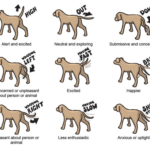When Your Dog Is A Teenager
When Your Dog Is a Teenager: Dealing with the Challenges
Dogs are known for their loyalty, playfulness, and companionship. They are often called man’s best friend for these reasons. However, like humans, dogs go through different phases in life. One of the most challenging phases is when they become teenagers.
Teenage dogs, like human teenagers, can be quite difficult to handle. They can become stubborn, disobedient, and even aggressive. As a dog owner, it is important to understand this phase and learn how to deal with it effectively.
In this article, we will explore what happens when your dog becomes a teenager and how you can navigate this challenging phase.
Understanding the Teenage Phase in Dogs
The teenage phase in dogs usually starts around six months to two years old. During this period, they may start exhibiting behaviors that were not present before. For instance, they may become more reactive to other dogs or people, start chewing things they shouldn’t be chewing on, refuse to obey commands they once knew well, or display other forms of destructive behavior.
One of the main reasons why dogs become challenging during their teenage phase is because of hormonal changes. Just like human teenagers going through puberty, dogs experience hormonal changes that affect their behavior and mood.
For male dogs, testosterone levels increase significantly during this period, making them more territorial and aggressive towards other dogs. Female dogs also experience hormonal changes when they go into heat which can cause anxiety or restlessness.
Another reason why teenage dogs can be difficult is that they are still learning about boundaries and social cues. They are trying to figure out their place in the world and who they are supposed to listen to. This means that they may test boundaries by ignoring commands or trying to assert dominance over their owners.
Dealing with Challenging Behaviors
Dealing with a teenage dog can be frustrating at times but it is important to remain calm and patient. Here are some tips to help you navigate this challenging phase:
1. Be Consistent with Training
Consistency is key when it comes to training teenage dogs. Stick to a routine and be firm with commands. If your dog displays inappropriate behavior, correct them immediately and redirect their attention to something else.
2. Provide Plenty of Exercise and Mental Stimulation
Teenage dogs have a lot of energy and need plenty of exercise to burn it off. Make sure they get enough physical activity each day by taking them for walks or runs. Mental stimulation is also important, so provide puzzle toys or obedience training sessions to keep their minds engaged.
3. Set Clear Boundaries and Expectations
Set clear boundaries for your dog and enforce them consistently. Make sure they understand what is expected of them and what is not allowed.
4. Use Positive Reinforcement
Positive reinforcement is an effective way to train teenage dogs. Reward good behavior with treats, praise, or playtime to reinforce positive behaviors.
5. Seek Professional Help if Needed
If your teenage dog’s behaviors are becoming unmanageable, seek professional help from a certified dog trainer or behaviorist.
Conclusion
Dealing with a teenage dog can be challenging but it doesn’t have to be overwhelming. By understanding the changes that occur during this phase and implementing proper training techniques, owners can successfully navigate this period and raise well-behaved adult dogs.
Remember to remain calm, patient, and consistent in your approach and seek professional help if needed. With time and effort, you can help your teenage dog become a well-adjusted adult companion for years to come!



